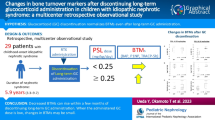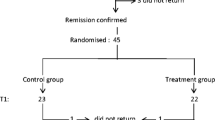Abstract
In this study we evaluated the effects of high-dose corticosteroid (CS) therapy and the character of the nephrotic syndrome (NS) itself on bones in patients with normal glomerular filtration rate. We measured serum osteocalcin (OC), alkaline phosphatase (ALP), intact parathyroid hormone (iPTH), 25-hydroxyvitamin D, calcium (Ca), phosphorus (P), and magnesium (Mg) levels, and urinary Ca and protein excretion in nephrotic children during the active phase before (group Ia) and after CS treatment (group Ib). The results were compared with age-matched control subjects. A significant increase in urinary Ca excretion was observed after CS treatment. Serum ALP, OC, and iPTH levels were within normal limits at the time of study entry. However, both serum OC and ALP levels showed a significant decrease after the completion of CS treatment (OC from 13.6±9.2 ng/ml to 6.7±5.2 ng/ml and ALP from 151.8±60.2 U/l to 116±43.8 U/l). 25-Hydroxyvitamin D levels increased to 17.2±8.9 μg/l from 9.9±6.9 μg/l after CS treatment. The effects of recurrent use of CSs were assessed by dividing nephrotic patients into two subgroups: infrequent relapsers (IFR) and frequent relapsers (FR). The cumulative dose of CS was 28,125 mg/m2 for IFR and 105,000 mg/m2 for FR. The changes in OC, ALP, and 25-hydroxyvitamin D levels after CS treatment were significantly different between IFR and FR. We conclude that high-dose CS treatment causes a decrease in bone formation, as shown by the changes in OC and ALP levels. 25-Hydroxyvitamin D levels remained lower than control subjects after CS therapy. The higher the cumulative dose of CS used the more marked the changes in biochemical bone markers. The contribution of FR to baseline 25-hydroxyvitamin D levels needs further study.
Similar content being viewed by others
References
Jones HJ, Peters K, Morgan DB, Coles GA, Mallick NP (1967) Observations on calcium metabolism in the nephrotic syndrome. Q J Med 36:301–320
Goldstein DA, Haldimann B, Sherman D, Norman AW, Massry SG (1981) Vitamin D metabolites and calcium D metabolism in patients with nephrotic syndrome and normal renal function. J Clin Endocrinol Metab 52:116–121
Chesney RW, Mazess RB, Rose P, Jax DK (1978) Effect of prednisone on growth and bone mineral content in childhood glomerular disease. Am J Dis Child 132:768–772
Lukert BP, Raisz LG (1990) Glucocorticoid-induced osteoporosis: pathogenesis and management. Ann Intern Med 112:352–364
Morrison NA, Shine J, Fragonas JC (1989) 1, 25 Dihydroxyvitamin D responsive element and glucocorticoid repression in the osteocalcin gene. Science 246:1158–1161
Demiaux B, Arlot ME, Chapuy MC, Meunier PJ, Delmas PD (1992) Serum osteocalcin is increased in patients with osteomalacia: correlations with biochemical and histomorphometric findings. J Clin Endocrinol Metab 74:1146–1151
Kutowicz MA, Riggs BL, Hall S (1990) Relationship of glucocorticoid dosage to serum bone Gla protein concentration in patients with rheumatologic disorders. Arthritis Rheum 33:1487–1492
Prummel MF, Wiersinga WM, Lips P, Sanders GTB, Saerwein HP (1991) The course of biochemical parameters of bone turnover during treatment with corticosteroids. J Clin Endocrinol Metab 72:382–386
Langman CB (1999) Disorders of phosphorus, calcium, and vitamin D. In: Barratt TM, Avner ED, Harmon WE (eds) Pediatric nephrology. Lippincott Williams and Wilkins, Baltimore, pp 529–544
Schwartz GJ, Brion LP, Spitzer A (1987) The use of plasma creatinine concentration for estimating glomerular filtration rate in infants, children and adolescents. Pediatr Clin North Am 34:571
Choukair MK (2000) Fluid and electrolytes. In: Siberry GK, Iannone R (eds) The Harriet Lane handbook, 15th edn. Mosby, St. Louis, Mo., pp 243–244
Gundberg C, Lian J, Gallop M (1983) Measurements of gamma-carboxyglutamate and circulating osteocalcin in normal adults and children. Clin Chim Acta 123:1
Endres DB, Villanueva R, Sharp CF (1989) Measurement of parathyroid hormone. Endocrinol Metab Clin North Am 18:611–629
Seamark DA, Trafford DHJ, Makin HLJ (1981) The estimation of vitamin D and its metabolites in human plasma. J Steroid Biochem 14:111–123
Saag KG (2003) Glucocorticoid-induced osteoporosis. Endocrinol Metab Clin North Am 32:135–157
Freundlich M, Bourgoignie JJ, Zilleruleo G, Abitbol C, Canterbury JM, Strauss J (1986) Calcium and vitamin D metabolism in children with nephrotic syndrome. J Pediatr 108:383–387
Freundlich M, Bourgoignie JJ, Zilleruelo G, Jacob AI, Canterbury JM, Strauss J (1985) Bone modulating factors in nephrotic children with normal glomerular filtration rate. Pediatrics 76:280–285
Grymonprez A, Proesmans W, Dyck MV, Jans I, Goos G, Bouillon R (1995) Vitamin D metabolites in childhood nephrotic syndrome. Pediatr Nephrol 9:278–281
Gomez-Alanso C, Naves-Diaz ML, Fernandez-Martin JL, Diaz-Lopez JB, Fernandez-Coto MT, Cannata JB (2003) Vitamin D status and secondary hyperparathyroidism: the importance of 25-hydroxyvitamin D cut-off levels. Kidney Int [Suppl] 85:S44–S48
Gessner BD, Plotnik J, Muth PT (2003) 25-Hydroxyvitamin D levels among healthy children in Alaska. J Pediatr 143:434–437
Rude RK, Gruber HE, Norton HJ, Wei LY, Frausto A, Mills BG (2004) Bone loss induced by dietary magnesium reduction to 10% of the nutrient requirement in rats is associated with increased release of substance P and tumor necrosis factor-alpha. J Nutr 134:79–85
Freundlich M, Jofe M, Goodman WG, Salusky IB (2004) Bone histology in steroid-treated children with non-azotemic nephrotic syndrome. Pediatr Nephrol 19:400–407
Huang JP, Bai KM, Wang BL (1992) Vitamin D and calcium metabolism in children with nephrotic syndrome of normal renal function. Chin Med 105:828–832
Leonard MB, Zemel BS (2002) Current concepts in pediatric bone disease. Pediatr Clin North Am 49:143–173
Anbroszkiewicz J, Gajewska J, Laskowska-Klita T (2002) Serum osteocalcin and bone alkaline phosphatase in relation to age and gender. Med Wieku Rozwoj 6:257–265
Tobiume H, Kanzaki S, Hida S, Ono T, Moriwake T, Yamauchi S, Tanaka H, Seino Y (1997) Serum bone alkaline phosphatase isoenzyme levels in normal children and children with growth hormone (GH) deficiency: a potential marker for bone formation and response to GH therapy. J Clin Endocrinol Metab 82:2056–2061
Lems WF, Gerrits MI, Jacobs JW, Vugt RM van, Rijn HJ van, Bijlsma JW (1996) Changes in (markers of) bone metabolism during high dose corticosteroid pulse treatment in patients with rheumatoid arthritis. Ann Rheum Dis 55:288–293
Author information
Authors and Affiliations
Corresponding author
Rights and permissions
About this article
Cite this article
Biyikli, N.K., Emre, S., Sirin, A. et al. Biochemical bone markers in nephrotic children. Pediatr Nephrol 19, 869–873 (2004). https://doi.org/10.1007/s00467-004-1537-6
Received:
Revised:
Accepted:
Published:
Issue Date:
DOI: https://doi.org/10.1007/s00467-004-1537-6




